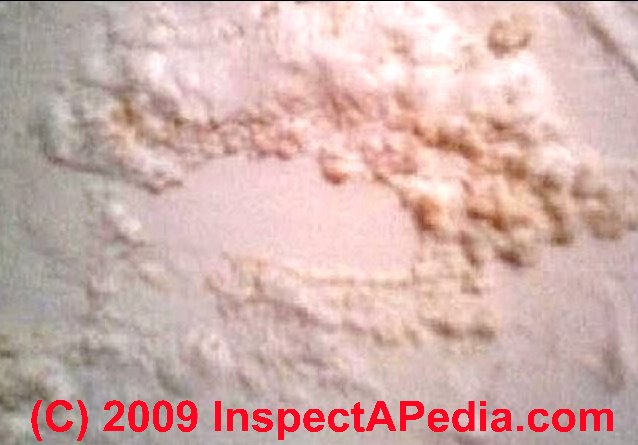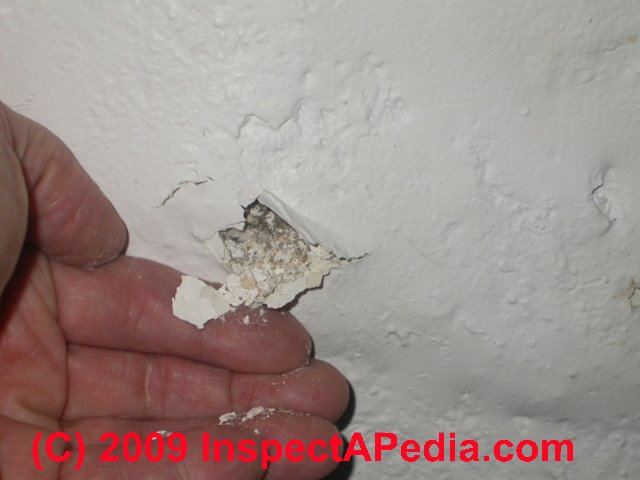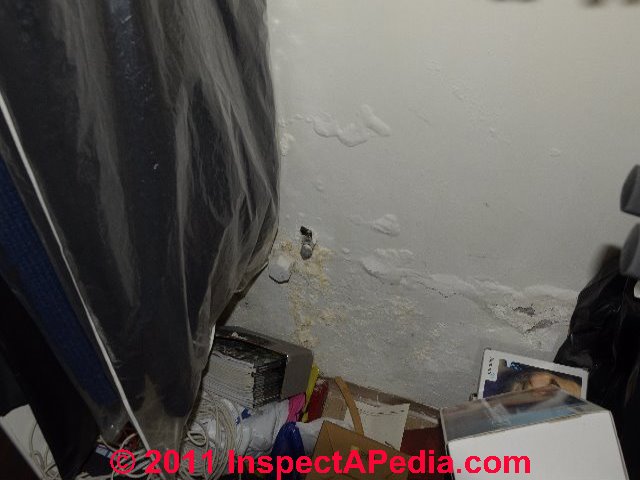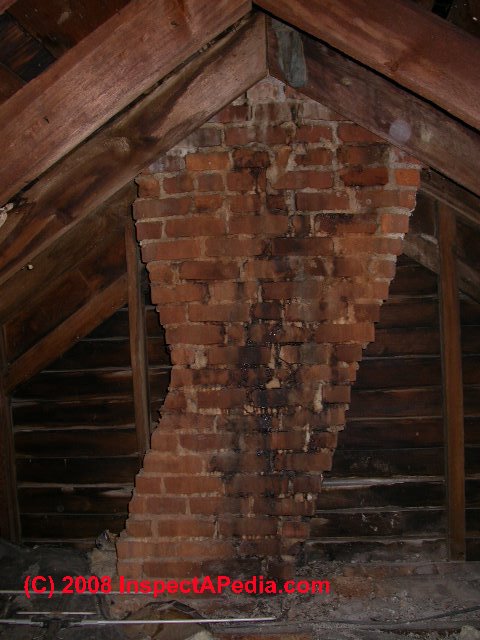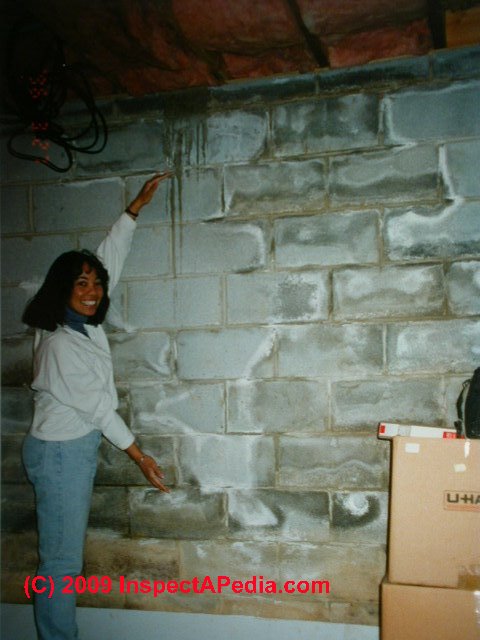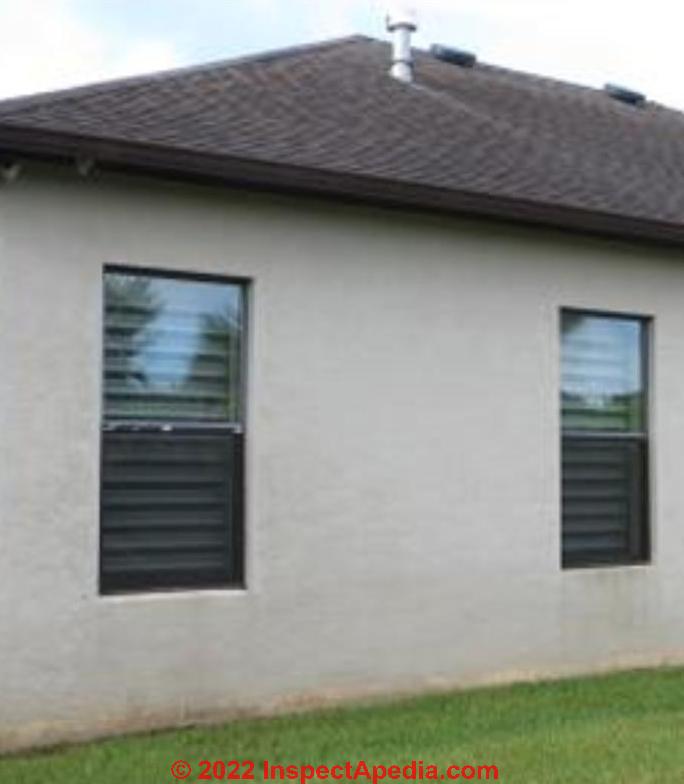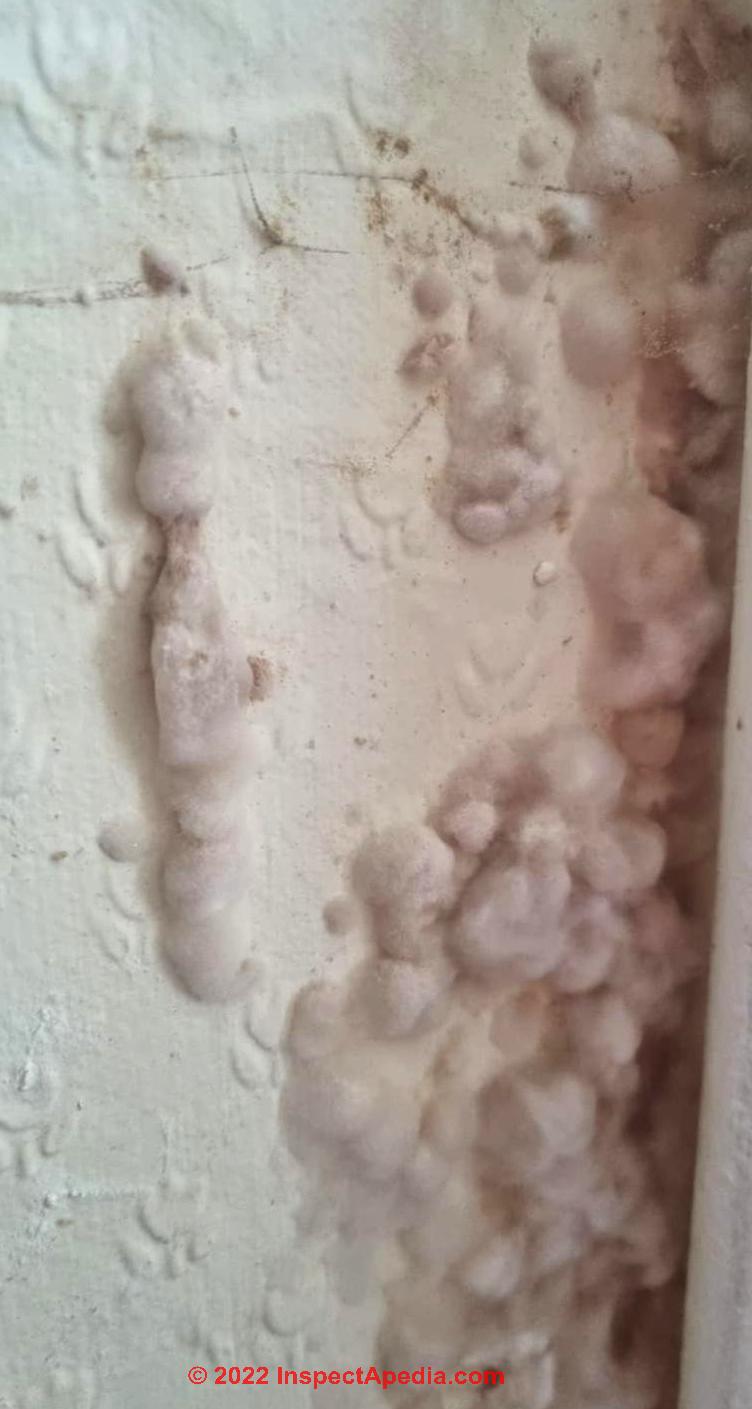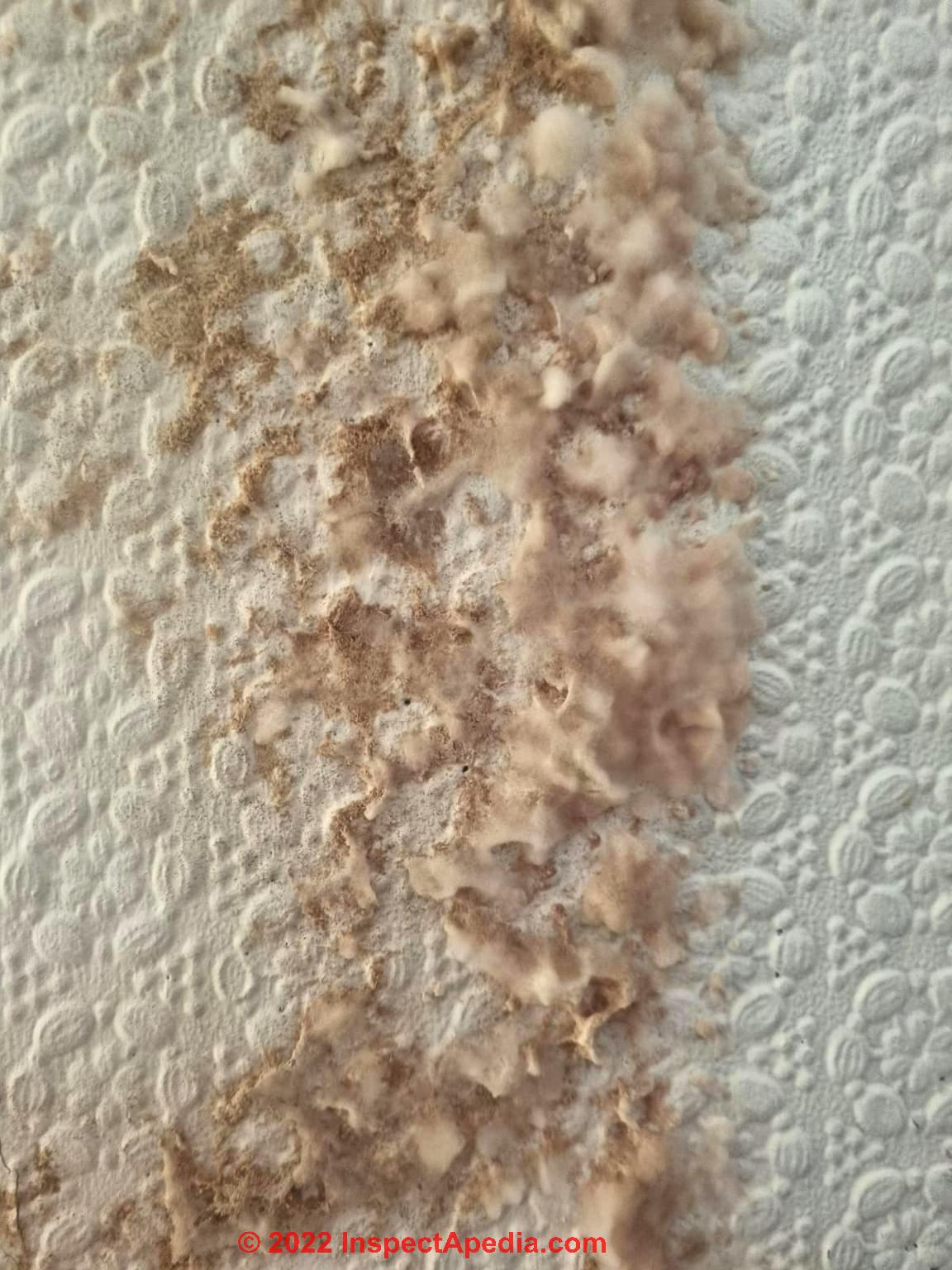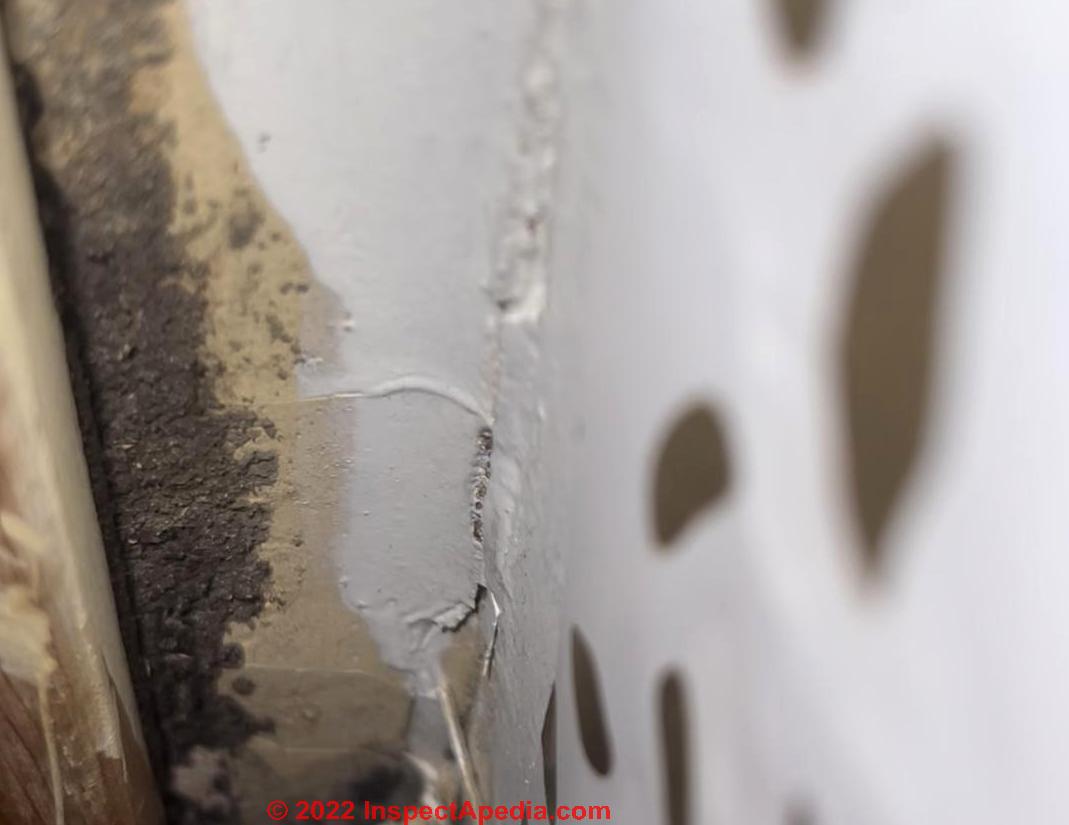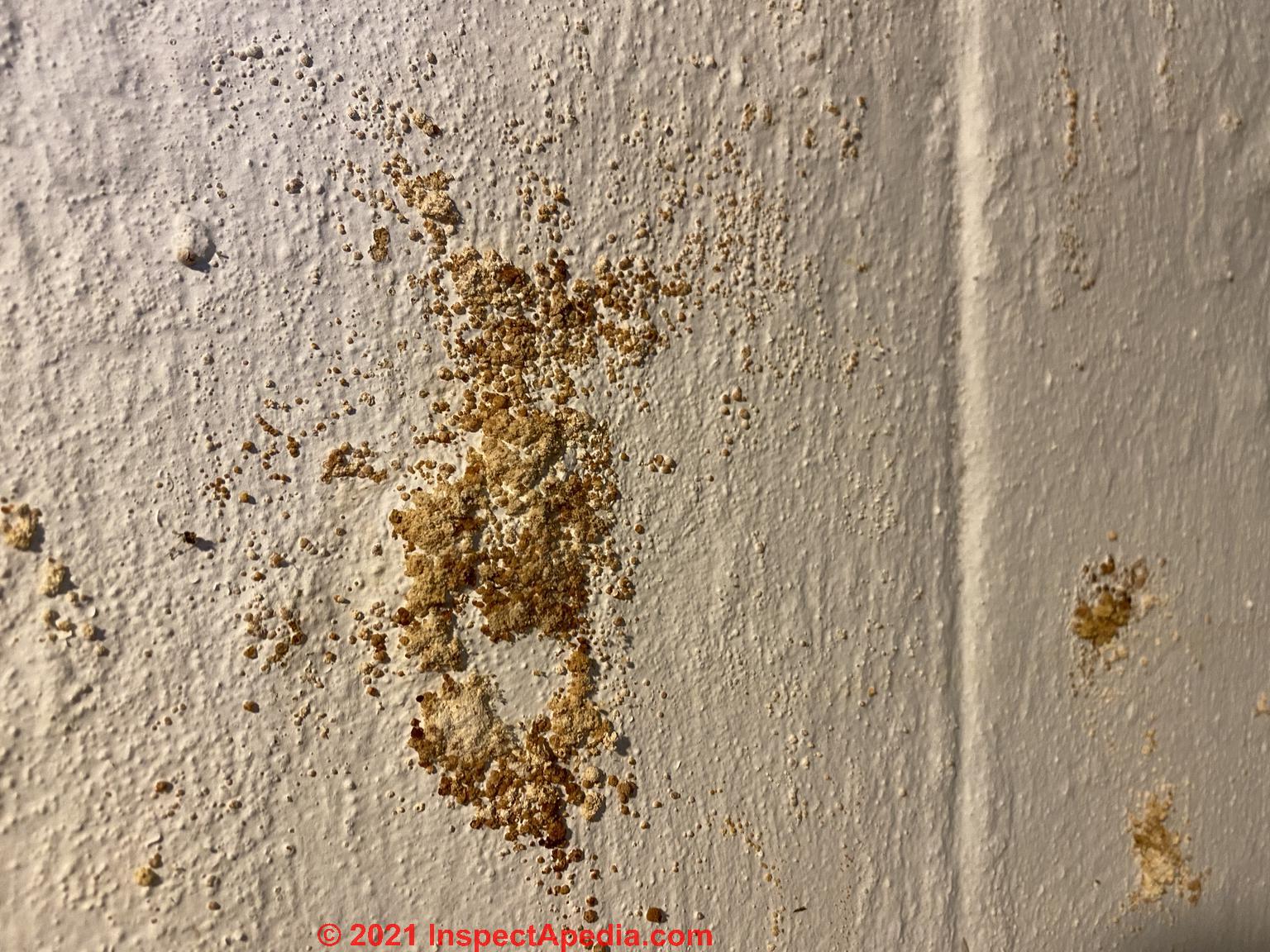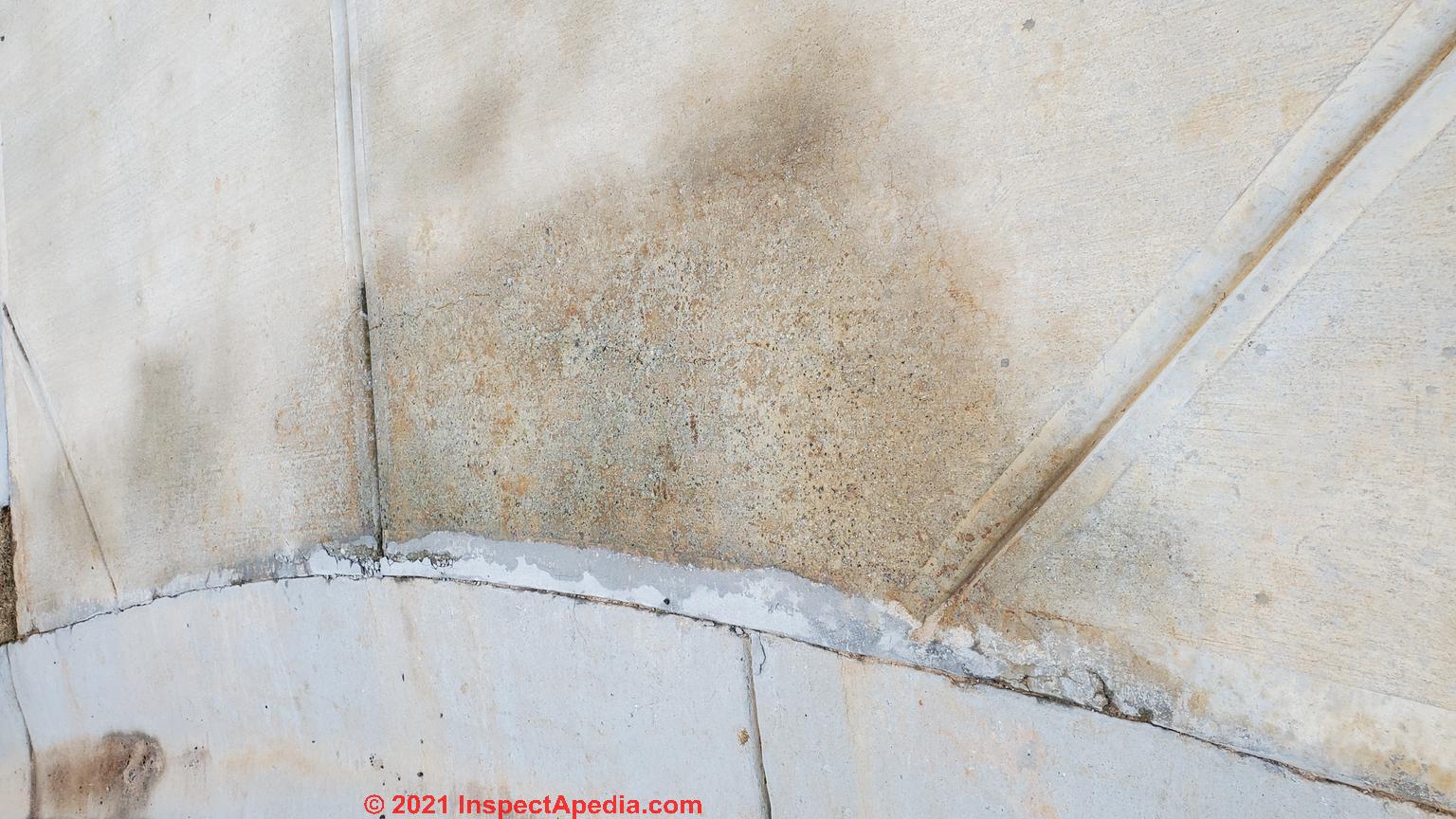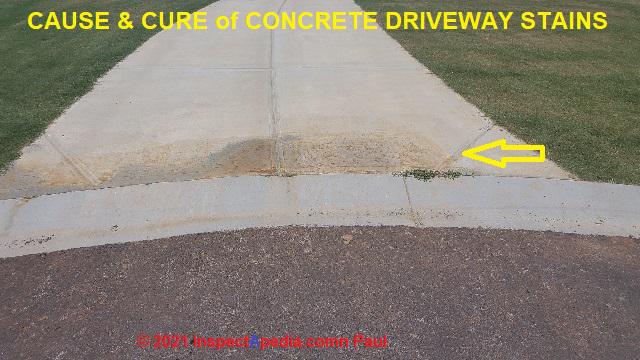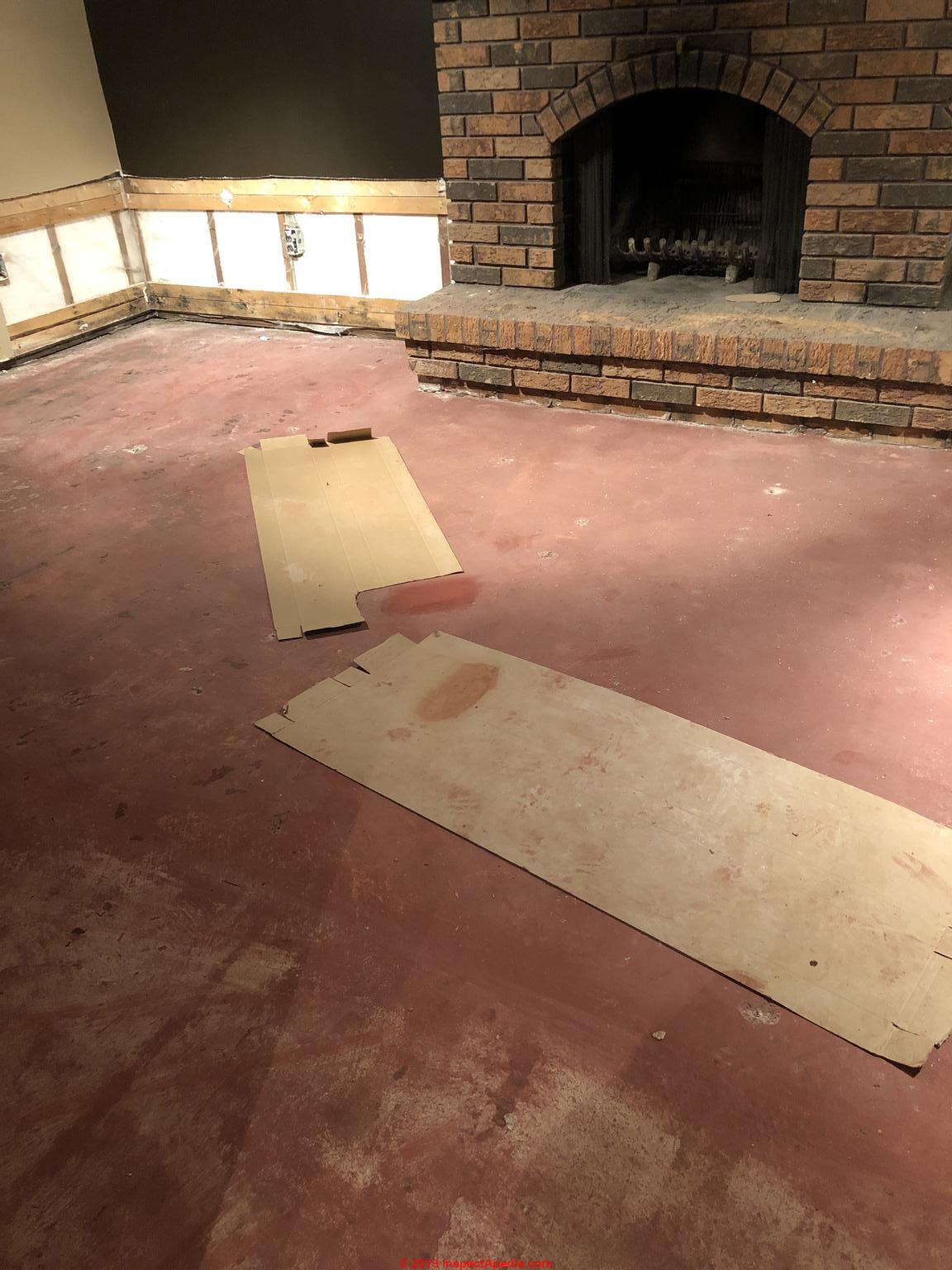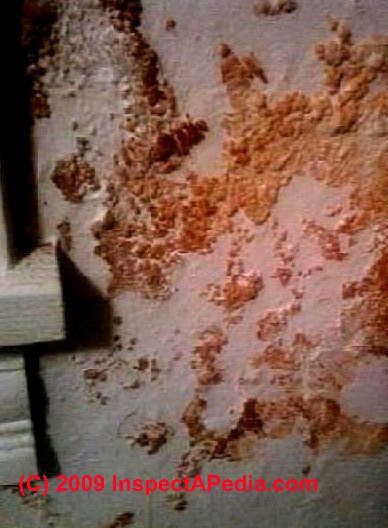 Brown and Red Mineral Efflorescence
Brown and Red Mineral Efflorescence
Salt Deposits, Brown & Red Bubbly Walls & Plaster - Diagnostic Photographs
- POST a QUESTION or COMMENT about the cause, cleanup, & prevention of brown or red stains & efflorescence deposits on building surfaces
Moisture & dark efflorescence, stains, or "growths" on building surfaces:
Red or Brown Building Stains & Deposits that are not mold:.
Here we illustrate and explain the cause & cure of reddish brown or pale yellow bubbly surfaces on walls, especially masonry walls or on masonry chimneys, caused by leaks & moisture - efflorescence and sometimes creosote leaks.
InspectAPedia tolerates no conflicts of interest. We have no relationship with advertisers, products, or services discussed at this website.
- Daniel Friedman, Publisher/Editor/Author - See WHO ARE WE?
What is the Brown or Reddish Bubbly Stuff Found on Building Walls?
When investigating a building for a mold problem, you can save mold test costs by learning how to recognize Stuff that is Not Mold or is only Harmless Mold but may be mistaken for more serious contamination - save your money.
Our photo at page top shows white fluffy crystals of mineral efflorescence near the bottom of a poured concrete foundation wall.
Because some clients have on occasion sent samples to our lab that really should not have been collected, much less looked-at, I provide this library of photographs of things that are "not mold" and don't need to be tested.
These are substances that you can easily learn to recognize in buildings.
Save your mold test money, and increase the accuracy of your mold contamination inspection or test for toxic or allergenic mold in buildings: review these items to learn recognize non-fungal materials or even possibly harmless cosmetic "black mold" often mistaken for "toxic fungal growth."
These photos of ugly reddish brown and white bubbly "growth" on a plastered masonry wall were sent to us by a reader.
This stuff looks like terrible mold but it's probably not mold at all. We won't know for sure without testing the material or inspecting the building.
But it sure looks like reddish-brown salts left behind by water and moisture passing through a masonry wall or a plaster wall, evaporating from the wall surface and leaving behind all of the crud that the moisture picked up from the wall itself as it passed through.
We often find this darker colored wall deposit on older buildings built of brick and stone whose interior wall surface is plaster applied directly to the masonry wall. We also often find this wall "growth" when water has been leaking in a plaster wall cavity.
Plaster is so alkaline that it is not as friendly to mold growth - it's not "mold proof" as mold may grow on or in paint or even on or in organic material in or on the plaster.
More red stains found indoors are discussed at STAINS on INDOOR SURFACES, PHOTO GUIDE
What is Causing the Bubbling and Peeling of Paint on Foundation Walls?
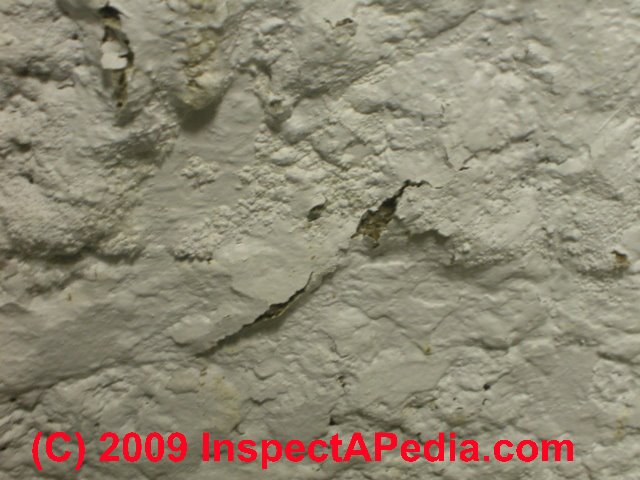
Take a look at this closeup (above) of peeling paint on a foundation wall in a basement. The lumpiness of the surface tells us that this wall has been painted a number of times, painting over a rough concrete or concrete block surface.
In the center of the photograph (above ) you can see where paint is falling away and the gray concrete or concrete block is exposed. At the upper left corner especially you can see rounded bubbles of material that looks as if it is "growing" on this foundation wall.
The author's hand (photo above right) shows a combination of peeling paint, deteriorated masonry surface, and mineral salts all left behind as water and moisture have been passing through the building foundation. There is a water problem in this building and a moisture problem, but the stuff on the wall and in hand is not mold.
These pictures shows combination of peeling paint and yellowish-white mineral salts left behind as water is passing through this wall as moisture or as actual liquid water.
The moisture is both pushing paint off of the surface and also leaving behind salts of various minerals that were dissolved out of the wall as the moisture passed through it. When water evaporates from a surface it leaves behind minerals that were dissolved in it.
In our photo at above left we see bubbling paint and plaster on an interior wall surface - an indication of the "lift" power of the mineral crystalline salts formed as efflorescence under a paint layer.
Diagnosis of White & Brown Stains on Brick or Concrete Block Chimneys
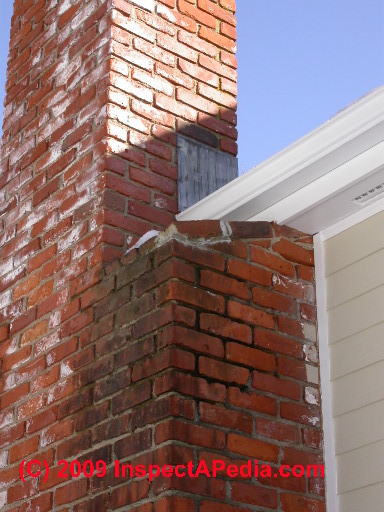
White powdery stuff appearing on a brick chimney may show up indoors or outside (photo above left). Brown stains leaking out of any chimney (photo above right), whether masonry or metal, may indicate a dangerous condition - prompt inspection is needed.
We find these stains on concrete block or "cinder block" chimneys as well, and occasionally on stone chimneys.
Brown stains on a chimney wall may
also show up indoors or outside (photo above right). The brown stains are probably from creosote or soot washing out of the chimney interior flue and leaking into the attic through the chimney wall. This chimney needs immediate inspection and repair.
In either case we recommend that you promptly hire a professional chimney sweep
to inspect the condition of the chimney including at the rooftop and inside the chimney flue. Water leaks into a masonry chimney can damage it and make it unsafe both structurally and with respect to leaking dangerous flue gases or even sparks that could cause a fire.
See CHIMNEY INSPECTION DIAGNOSIS REPAIR for details.
Diagnose, Remove, Prevent Brown & Gray Efflorescence & Growths on a Concrete Slab Floor
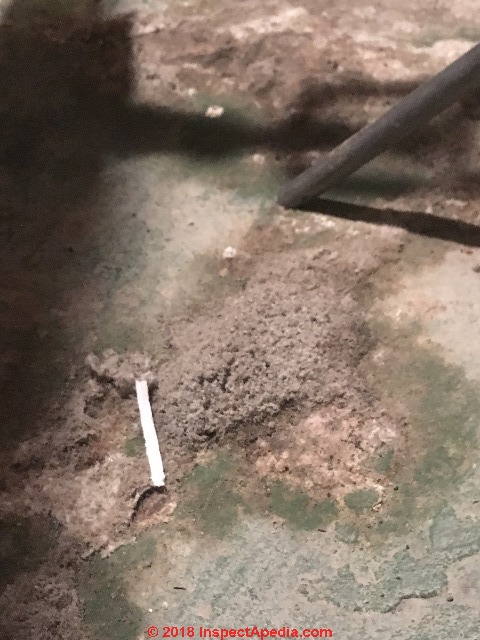 Question: what is this gray, brown, and white fluffy stuff on our basement slab?
Question: what is this gray, brown, and white fluffy stuff on our basement slab?
Our home was built in 1915, and probably hooked up to the combined sewer that was in place after 1906. Their mistake, in hindsight.
We have a sewerage district that has wisely begun uncoupling those old connections where separation was not required.
Walked down to the basement today and found a bunch of these little deposits. They’re moist spots, with maybe some efflorescence, but a gray, dusty/powdery layer over it. All over, various sizes/density. Have not noticed them until now.
[Click to enlarge any image]
I can’t tell if this is:
1) Basement crud (lint, fur, dust) collecting on moist spots
2) Moisture that is seeping up and generating mold, on top of efflorescence
3) some other gross accumulation
I don’t notice a smell at all, so I would rule out animals.
I opened the basement heat vent a few weeks ago, which I think was a mistake. The dehumidifier shows 40-45 humidity, and has all winter. That humidity and the temp seems way too low to generate/support mold growth. - Anonymous by private email 20 March 2018
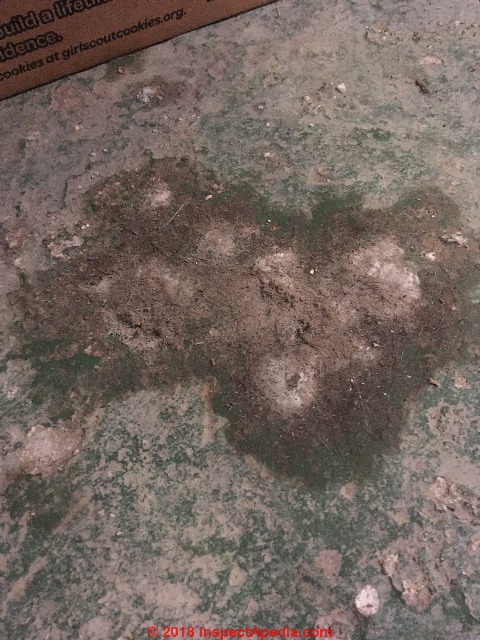 Reply: probably efflorescence; focus on sewage backup cleanup & sanitizing
Reply: probably efflorescence; focus on sewage backup cleanup & sanitizing
The photos are a bit blurry and of course a lab analysis is a much more accurate answer to your question, but what I see looks to me like efflorescence with possibly some green mold growth.
Mold does not much like raw concrete, but mold of many species will grow on organic debris that might be on concrete, more so if it's enriched by sewage or sewage effluent. That means there could be bacterial hazards as well.
It would make sense to clean and sanitize the surface, then give some attention to
1. inspection of the sewer line to be sure it's intact
2. steps to dry out the area - see WATER ENTRY in BUILDINGS - home - as a reasonable place to choose among diagnosis and remedial steps
Reader Follow-up:
I learned a lot by spending some time on the site last night. I'll do some clean up and dry out this weekend and see what happens.
We are looking at disconnecting/capping the downspouts that feed into the foundation drain from the roof, as well as a French drain in the back where a slope comes down to the house from the rear of the lot (high point).
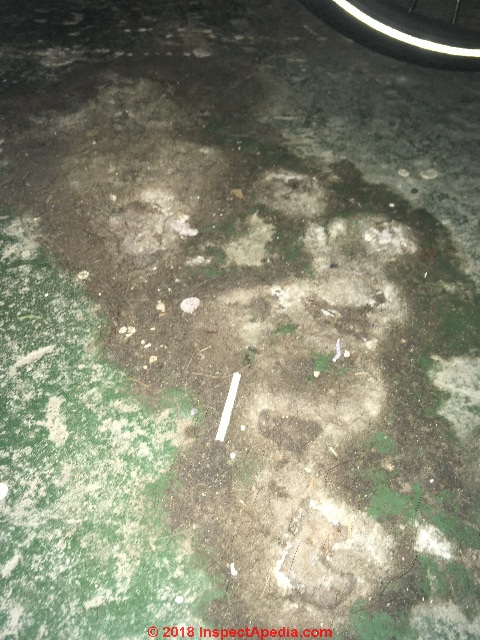 at some point, we will need to re-cover or repair and level the floor. I'd like to find a better (and more cost-effective) management for this issue in the meantime.
at some point, we will need to re-cover or repair and level the floor. I'd like to find a better (and more cost-effective) management for this issue in the meantime.
There was a known sewer backup through the floor drain from a combined sewer a few years ago, and there are water marks around the columns, but the dark spots here are moisture welling up through the floor (which is painted green).Sorry the images were so large, I attached a smaller one with a bit better resolution.
Thanks for what you do, this kind of information and advice is so helpful.
Reply: why mold can grow on concrete
Your message reminds us of the difficulty of guess-diagnosis of building conditions from afar. In virtually 100% of the cases in which I haven't visited the property I have found important data that significantly amended or improved our diagnosis over what we might first have seen by email.
For example it's a classic mistake to connect downspouts conducting roof drainage injury foundation drain system.
That overloads the foundation drain or the life of the building on the foundation drain system becomes clock with those conditions send significant amounts of water under the foundation under the slab.
Heading to the previous sewer backup means we've added nutrients that would invite both balding bacterial growth. I think you're quite right start outside getting roof runoff well away from the building. And you want to clean sanitize the slab.
Looking again at your photos I think there could be fungal growth along with of course other substances, though the first best guess remains efflorescence You could probably confirm efflorescence by shining a bright light obliquely along the substance to look for shiny crystalline structures that will be more obvious under a hand magnifier.
There are as well mold species that will grow on almost anything, but on concrete where I find mold (such as an old concrete basement floor) usually the mold is growing on some organic deposits: possibly in this case sewage remnants?
A cleanup that addresses a sewage backup would probably be fine for removing the mold too; I'd follow any sanitization or disinfection by a careful inspection to be sure we're doing all we can to keep the area dry
. Aside from the water entry in buildings link I gave before, if you haven't done so, see the steps
at BUILDING DRY-OUT PROCEDURES
and at WET BASEMENT PREVENTION
What Does it Mean to Find Efflorescence and Stains in a Building Interior?
MOLD & HEALTH WARNING: although efflorescence is not mold, it often indicates wet conditions that cause problem mold growth elsewhere in the same building.
You'll need to identify the sources of moisture or leaks and correct them, and depending on other building air quality complaints or health concerns it may be appropriate to inspect and screen the building for problem mold or other moisture or water-related problems.
Where you find efflorescence in a building indoors, you should look for problem mold, allergens, bacteria. Look on organic surfaces - wood, paper, painted surfaces, insulation, fabrics, carpets, carpet padding, or in settled dust and debris.
In our photograph (above left) the client is pointing out that water has been entering this basement from the very top of the foundation wall (due to outside roof spillage and bad drainage) - we did not agree with the contractor who told her this was "rising damp" due to wet soils.
Remove & Prevent Efflorescence on Building Surfaces & Materials
This discussion has moved
to EFFLORESCENCE REMOVAL & PREVENTION
...
Reader Comments, Questions & Answers About The Article Above
Below you will find questions and answers previously posted on this page at its page bottom reader comment box.
Reader Q&A - also see RECOMMENDED ARTICLES & FAQs
On 2022-09-18 by Tammy Dunlap
My home in florida has discolored foundation the entire way across the north side. it is concrete block construction and stucco finish. the soil is very damp along the foundation, even though there are good gutters in place. wondering if the weep screed was omitted during construction or the land wasn't properly prepped? Thanks.
On 2022-09-19 by InspectApedia-911 (mod)
@Tammy Dunlap,
What you speculate is possible but that stain pattern most of the time is caused by spillage off of the roof. Without a closer inspection I wouldn't assume that your gutters are working correctly.
On 2022-09-19 by Tammy Dunlap
@InspectApedia-911, thanks for your reply. The gutters don't seem to be leaking when it rains, yet dampness is present all the way to the foundation. Perhaps wind driven rain since it is on the north side of house. I wonder why the concrete is absorbing it if the weep screed is there. Can weep screed be installed retroactively? Thank you.
On 2022-09-19 by InspectApedia-911 (mod) - be sure finish grade slopes away from the building
@Tammy Dunlap,
We don't really know how that wall was constructed unless you have photos of the construction process,
but that staining near the ground sure looks like water splash-up; In Florida there'll be no basement - I'm assuming this is slab on grade.
If your floor level inside is above the finish grade outside that reduces the concern for water entry.
And yes, look carefully at the finish grade to be sure it slopes away from the building... But you might have someone good with a moisture meter check those interior walls near the floor.
On 2022-04-20 by Charlie - what is the pink fluffy stuff growing in the basement?
Hi, we’re renovating the basement of my grandparents house and have come across a lot of white and pink fluffy fungus / mold and are worried it could be dry rot? Hope you can help! Thanks :)
On 2022-04-20 by Inspectapedia Com Moderator - pink fluffy stuff growing in the basement
@Charlie,
Take a close look, perhaps using a magnifying glass. If you see that the white fluffy material is crystalline in structure then it is efflorescence as described on this page and not a fungus.
Of course, keep in mind that whenever you have water leaking into a building causing efflorescence in a location, there may be moisture related mold nearby.It would help me make a better guess at what is in your photos if we knew how that wall is constructed.
If it's a masonry wall then mineral salts or efflorescence would be expected.
If it is a wood-framed wall, then indeed it would be appropriate to look into the wall cavity for water damage and rot.
On 2021-12-31 by Sarah - what is this stuff growing in my daughter's closet? Mold?
Hi! I was doing some post holiday organizing in my daughters closet and somehow I managed to notice this. It is in a very obscure corner of the closet (on the inside by the closet door trim, there is about a 1 1/2 piece of wall and then it turns into a corner and meets the other wall)
Whatever this is, is growing up the side of the trim and on the wall. I have a contractor and exterminator coming this week to hopefully determine if it is mold or old termite damage/tubes.
A little background..house was built in the 50’s and most walls are plaster. No known leaks since we purchased it 4 1/2 years ago. There was prior termite damage that we have had repaired and the house has since been treated. I’m terrified bc it’s in my daughters closet and I’m worried that it is black toxic mold.
Thank you so much in advance for any assistance you can provide! (P.S. the gold spots on the right hand wall is just the wallpaper)
On 2021-12-31 by Inspectapedia Com Moderator - find the mold and its cause and remove both
@Sarah,
Yes that looks like mold.
Watch out: focus on "Toxic black mold" - a result of various popular media accounts - is a serious dis-service to the public. First, not all black mold is toxic - some is harmless, and second and more important, there are many more harmful mold genera/species found growing on or in buildings and building materials that are not black, and can be any other color: white, green, red, orange, yellow, brown, tan, tray, etc.
Second: resist being terrified - as that anxiety may be more of a health hazard than mold, and it certainly risks connecting you with someone who will open your wallet and simply pour out a torrent of your money that may not be appropriate nor necessary.
Third: yes that looks like mold. If there is more than 30 sq.ft. of contiguous mold you'd hire a remediation contractor; else such cleanup jobs are within the scope of a normal homeowner or handyman.
Find the mold, remove it.
Find the cause: building leaks, water, moisture, and fix those.
The articles found in the Index to Related Articles give full details on how to find, remove, clean up and prevent harmful mold in buildings. Please do take a look and let me know if you find any of our information unclear or raising un-answered questions.
On 2021-12-31 by Sarah
@Inspectapedia Com Moderator, Thank you! I’m just so confused bc there is no evidence of a leak anywhere (I know some leaks can’t be seen) but there is no damage to the ceiling above it, the walls surrounding it, the door trim or anything upstairs from it. This is at the bottom foot of the wall.
Ugh! It’s plaster and I’m kinda scared to look
On 2021-12-31 by Inspectapedia Com Moderator - Inspect the wall cavity and cavity side of the drywall for mold
@Sarah,
Inspect the wall cavity and cavity side of the drywall for mold.Plaster is less mold-friendly and a bit more work to remove or cut-into; your original photo was pretty blurry. Take a closer look to be sure it's mold.
On 2021-07-29 by Paul - builder agreed to replace improperly-poured slab that has stains and odd markings
@inspectapedia.com.moderator,
So I went back to my builder again, feeling more confident thanks to things I've learned here.
They've now finally agreed to bust and remove the slab all the way up to the first stress joint and re-pour the entire section. They say that since my drive was poured in the winter, they often put a healthy amount of calcium into the mix and that sometimes the calcium can clump together and cause this issue.
Interested to hear thoughts on that. Ultimately will be satisfied in any case, so long as they follow through on the re-pour now.
On 2021-07-29 by inspectapedia.com.moderator - diagnose cause & give cure for red-brown stains on recent concrete driveway: inadequately-mixed cold weather accelerator ?
@Paul,
Thank you for that follow-up; it will help other readers to learn that sections of a concrete pour give mixed and sometimes poor, stained, or scaling surfaces that may be traced back to the conditions at the time of the pour combined with additives to the concrete combined, I suspect, with un-even mixing as the concrete was placed.
Specific to this case, Calcium - actually Calcium Chloride (CaCl) - a salt - was added to your concrete mix to control setting in cold weather. Calcium chloride as an admixture is mixed into concrete at a ratio of about 2 percent of CaCl by weight to accelerate the setting of the concrete, in an effort to avoid frost or cold-weather damage to the pour.
The use of CaCl is limited to a maximum amount by ACI CODE-318-19: Building Code Requirements for Structural Concrete but if you read the specifications and details you'll see that interpretation and application of the guidelines can be tricky as there are multiple weather and structural factors to consider, and because standards differ for an on-ground slab such as a driveway in compared to concrete that must support a structure.
For other readers: ACI Code 318:
Description:
The “Building Code Requirements for Structural Concrete” (“Code”) provides minimum requirements for the materials, design, and detailing of structural concrete buildings and, where applicable, nonbuilding structures. This Code was developed by an ANSI-approved consensus process and addresses structural systems, members, and connections, including cast-in-place, precast, shotcrete, plain, nonprestressed, prestressed, and composite construction.Among the subjects covered are: design and construction for strength, serviceability, and durability; load combinations, load factors, and strength reduction factors; structural analysis methods; deflection limits; mechanical and adhesive anchoring to concrete; development and splicing of reinforcement; construction document information; field inspection and testing; and methods to evaluate the strength of existing structures.
- source: American Concrete Institute (ACI), ACI World Headquarters, 38800 Country Club Dr., Farmington Hills, MI 48331-3439 USA https://www.concrete.org/store/productdetail.aspx?ItemID=318U19&Language=English
Example Instructions:
CONCRETE / CEMENT MiX ACCELERATOR INSTRUCTIONS [PDF] Sakrete,
On 2021-07-28 by Bridget M - what's this stuff growing on my basement wall?
Hi, I have this stuff growing in several spots on my basement wall. My husband says it’s mineral deposits, but I’m worried it’s mold. Most of it is a golden color. Any ideas?
On 2021-07-28 by inspectapedia.com.moderator (mod)
@Bridget M,
That looks like efflorescence to me
On 2021-07-21 by Paul - discussion leads to diagnosis of cause of ugly stains on two year old concrete driveway
Hey all, hope to understand what's happening here. My driveway has had this problem for almost 2 years now.
You can see in the picture [above] where the contractor tried to "repair" this issue once already, to almost no effect.
My suspicion is that this portion of my driveway was not dug out deeply enough, resulting in water and mud seepage and the associated deterioration and fracturing. And that the only proper repair will be to tear it out, dig it deeper, and re-pour. Thoughts?
On 2021-07-21 by inspectapedia.com.moderator (mod)
@Paul,
Thank you for the helpful question on driveway stains; I can't tell for sure and an onsite expert will always see and know more than we can from afar, but
to me that looks like
1. there is water seeping up through the concrete - that won't bring much soil, silt, etc. but that area of the concrete will be wet longer than its surroundings after wet weather has passed to a dryer time and you may see slight surface deterioration -
Rx: if you can't divert water away from the area with surface measures sufficient to get the subsurface water level down, it may be necessary to break up the drive, install better drainage below, and pour anew;
2. that area of concrete doesn't drain as well as the surrounding surface - you may find soil and silt and debris that wash into and collect in that area and that are easily lifted off, swept aside, or collected for analysis
Rx: about the same as #1, but may be easier to fix - e.g. is roof runoff spilling across this area? If so, redirect it. (Or you may need a buried downspout line)
OR
3. the original pour in that area was a bad mix; so we might see loss of the surface finish, and we might speculate that there was soil (dirt) in the concrete that was poured in those stained locations;
Rx: Remove and replace the sections between control joints
I note that it looks as if there has been patching along one edge of four sections of concrete; that suggests frost damage and/or water damage, possibly subsurface water,
Sorting those out helps us diagnose the cause: we need to have confidence that we know the cause of a stain before we prescribe its remedy.
On 2021-07-23 by Paul
@inspectapedia.com.moderator,
Hi, thanks for the reply. Hopefully I can provide some clarifying information. This area does indeed stay dark and wet for significantly longer than the rest of the driveway, and also gets much darker to begin with when it rains. (Depending on relative humidity and cloud cover, it can stay dark and wet for upwards of 48 hours after the rest of the driveway has resumed its normal coloring).
Surface drainage and water runoff on top of the driveway is fine, there is never any puddling or surface retention in this area or any other. Below is a link to a small Google album with more pictures. Some of these were taken in July 2020 (when the driveway was less than six months old) and as you can see the staining and deterioration were already well underway.
Sometime around November of 2020, the contractor attempted a "fix" that involved trying to sand off the staining on top and then re-pouring that front edge that you see, as the deterioration was worst there. However, neither action accomplished anything. The small re-pour is coming apart the same as the old did, and the sanding did little for the stain (as it's coming from below).
The second set of pictures was taken in March of this year, so as you can imagine it has gotten even worse since then, as it rains almost every evening in June & July where I live. The website doesn't like my link, so you may have to remove spaces I added or insert a . where I write (DOT) to get it to go through.
photos(DOT)app(DOT)goo(DOT)gl/P4a9aukpFHgwAxwu8
On 2021-07-23 - by (mod) - photos & causes of mottled gray stains on driveway
@Paul,
Thanks for the additional photos;
CommentBox blocks comments that contain links, until the moderator can approve them - to protect readers and the website from malware;
I am posting one of your driveway stain photos below - on this page, though you will also want to see
CONCRETE STAINS: ID & REMOVAL - un-wanted stains or defects or discoloration
where we'll eventually move this discussion.
Given the perspective of the photo below - it looks as if stains are where the drive meets the asphalt-paved street or cul-de-sac.
I'm not sure if the problem is a contaminant that was in the soil below this part of the pour or a water problem in the area;
If the problem is only in this one location, to remove it may require removing the concrete down to the soil, checking the drainage there, and making a new pour.
Rather than break out more of the concrete than necessary, the contractor might consider using a concrete saw to cut a suitable expansion joint cut to isolate the stained segments for removal.
On 2021-07-23 by Paul - causes of stains and marks on concrete driveway
Yeah I encountered the filter on the first post the other day with the picture, and it gave me a message about the post awaiting review. This time, it just flat blocked me and told me I was spam, with no "under review" message and no other option, haha.
But yes, this is the only place on the drive this happens, and it gets that dark coloration after it rains, 100% water-related.
I have long presumed a poor pour/drainage/mix, but the contractor has resisted that diagnosis for over a year, as they do not want to do what it is plainly evident now would be necessary to fix this.
So, wanted to check with folks here to make sure I wasn't crazy or there wasn't something else I was unaware of.
On 2021-07-23 - by (mod) -
@Paul,
I don't think so; the localization, relationship to water, and surface appearance all suggest there may have been a bit of dirt in the mix or a contaminant under the pour that's pushed up by water;
I didn't see in the photo any nearby street or storm drain; are we confident we've not got some area drain towards the drive end?
On 2021-07-23 by Paul - discussing cause of defects in concrete slab
Correct, there is no storm drain at all in our cul-de-sac, as it slightly uphill from the street (the drain is about 100 yards down the street from the end of my driveway, at the top of the cul-de-sac).
The runoff largely behaves correctly, running down the curbs/gutters to the storm drains.
Both of my neighbors are likewise on slight elevations from the cul-de-sac and neither have this issue.
In fact, no one else in the neighborhood has this issue, although I know some have significant fracturing that seems/feels disappointing for pads that are not even two years old.
Moreover, you'll note that in the pictures from 2021 you can see a sidewalk adjoining the driveway that was not present in the pictures from 2020. The developer/contractor installed these in early February, but only after a battle wherein our HOA threatened legal action (long story).
The sidewalks likewise do not have this staining or water issue, even the portions of them directly adjacent to my driveway. Not yet, at least.
On 2021-07-23 by inspectapedia.com.moderator (mod)
@Paul,
It really sounds like a bad mix [or as it develops, improper mixing-in of an additive concrete set accelerator in cold weather - Ed.]
On 2021-02-14 by Evan - how to fix damaged concrete block foudnation wall - crumbly brownish spots
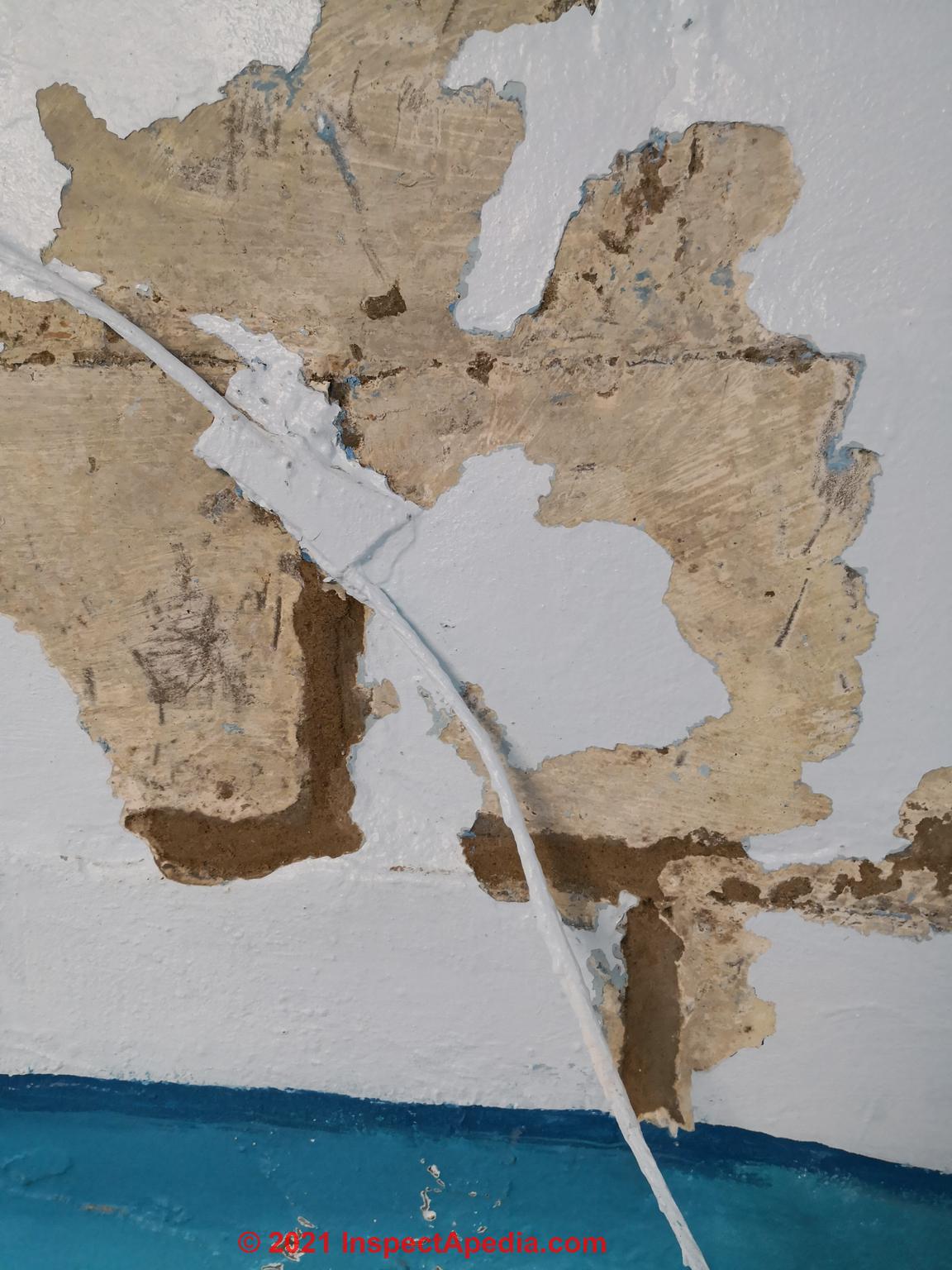 Hello, When looking at repairing some damage to my concrete block foundation I have noticed that there are a few spots where instead of just crumbly concrete spots, there are also some brownish crumbly spots that look more like dirt. This seems different then the pictures of brown spots in your post. I'm wondering if you can help identify and let me know how best to treat this.
Hello, When looking at repairing some damage to my concrete block foundation I have noticed that there are a few spots where instead of just crumbly concrete spots, there are also some brownish crumbly spots that look more like dirt. This seems different then the pictures of brown spots in your post. I'm wondering if you can help identify and let me know how best to treat this.
An additional question is where there are small cracks and a few larger gaps in a few mortar spots. Do you think that those need to be repo in red with mortar or are mortar caulk OK?
On 2021-02-14 - by (mod) -
Evan
That looks to me as if someone used an odd, maybe DIY, mortar mix to try to patch open mortar joints in the block foundation wall. I see what looks like peeling foundation waterproofing paint - not a bad product but it won't remain adhered to a concrete block wall if that surface is not- properly cleaned before painting with the waterproofing sealant
- the water source is not found and stopped
If the material is intact, just parge-coat over it; if it's really just mud and is thus quite soft, it may be easily removed by a garden hose sprayer; in that case clean it out and use proper mortar for a repair before coating the walls
On 2021-02-15 by Evan - repointing with hydraulic cement
thank you for your response. Because I'm hoping to eventually paint the surface, do you think repointing with hydraulic cement would work.
I just want to make sure that we won't keep getting crumbly mortar and voids the paint. We even found some mold behind the paint in some spots.
On 2021-02-15 - by (mod) -
Yes that's worth a try
On 2019-11-22 by Angela Payne- red powder-like substance all over the concrete basement floor.
Hi, my basement was recently flooded (excessive winter thaw - cracked foundation).
When the laminate and subfloors were removed, we discovered a red powder-like substance all over the concrete basement floor.
The house was built in 1955 and I am concerned that this red stuff might contain lead and/or asbestos. Please see attached image.
On 2019-11-22 1 by (mod) - red stuff found after removing a laminate floor surface
Angela,
Thank you for the interesting question and photo;
You say that you removed a laminate floor material and a subflooring; by laminate I take that to be a wood or plastic engineered flooring; by subflooring I'm uncertain if you mean a layer of plywood or OSB sheathing or if you mean a red rosin paper.
Therefore I'm not sure what that red substance is on the concrete floor surface; could it have been painted on as a sealant or is it a residue from the under-side of flooring that was removed? Look o the back of some of the removed flooring for more clues and if possible post a photo.
On 2018-08-03 by DLL - November concrete slab pours - effloresence, brown stains, can't wash off
We poured a couple exterior slabs last November and covered as soon as it was set enough to not damage the broom finish.
The low temperature was in the 40s during the day and 30s at night. We left the slabs covered while work continued. When we uncovered the slabs there were ok but some efflorescence that appears when concrete is covered soon after placing.
There are brown stains on the concrete that makes it look dirty. Pressure washing has no effect and we tried some mild cleaners but they have no effect on the brown stains but do help with the white efflorescence.
Any ideas what caused the brown staining. It's kind of modeled & uneven but seems to be into the concrete.
On 2018-08-03 by (mod) - brown stains on concrete
DLL
Sorry but I can't guess usefully from just your text. Possibly there were inclusions in the concrete that are causing the stains. I'd like to see some sharp photos.See CONCRETE STAINS: ID & REMOVAL for details
Question: tan fuzzy stuff on inside of shed roof in 6" strings
(Apr 20, 2014) linda haytop said:
tan fuzzy stuff on inside of shed roof. 6" 'strings' hanging down with black half moon shaped things. dripping out sticky substance. clusters of cream balls. help! what is it?
Reply:
Linda I can't imagine from just the text note. Use the CONTACT link found at page bottom and send me some sharp photos and I'll comment further.
Watch out: if this is termite damage. You'll want to check out: TERMITE DAMAGE INSPECTION
Question: efflorescence around a stone fireplace
(June 4, 2014) Anonymous said:
I have what appears to be efflorescence on a home interior rock wall (fieldstone?) surrounding a fireplace. Most of the deposits are white but there are some darker patches above the fireplace (not used for years) where the stone has started to deteriorate. I brushed and then vacuumed all areas which improved the appearance. This problem has been going on for at least 4-5 yrs and the house has been closed up each winter for many years
I'm not sure about products to clean it like Magic Acid, etc. because I'm concerned that cleaning materials may discolor the stone and make it look worse. The mission is not to solve the root cause but to improve the appearance. Suggestions are greatly appreciated.
From Neil Hochman NH83151@aol.com
Correction to Anonymous/Neil Hochman post:
The fireplace wall is NOT fieldstone but a greyish/blue stone of uncertain composition laid out brick style surrounding a bluestone fireplace hearth not affected by the efflorescence.
(June 8, 2014) Neil Hochman said:
RE: Earlier post about efflorescence on indoor fireplace wall.
The first comment was accidentally send under Anonymous and has disappeared from the thread. Need to remove efflorescence patches from the stone wall described below but am worried about what product to use as staining might result?
Powder has been brushed off and vacuumed. What do you recommend for safe cleaning? Thank you.
Reply:
Neil:
Watch out: check your chimney cap, crown, sides, and flashings for leaks - any of which might make the chimney not just leaky but unsafe.
...
Continue reading at EFFLORESCENCE SALTS & WHITE DEPOSITS or select a topic from the closely-related articles below, or see the complete ARTICLE INDEX.
Or see these
Recommended Articles
- CONCRETE STAINS: ID & REMOVAL
- EFFLORESCENCE SALTS & WHITE DEPOSITS
- EFFLORESCENCE: WHAT IT LOOKS LIKE IN or ON BUILDINGS
- EFFLORESCENCE: USE LIGHT TO SEE IT
- EFFLORESCENCE UNDER the MICROSCOPE: IDENTIFICATION
- EFFLORESCENCE: IMPLICATIONS for BUILDING CONDITION & SAFETY
- EFFLORESCENCE AGE: HOW OLD IS IT?
- EFFLORESCENCE vs MOLD: HOW TO TELL THE DIFFERENCE
- EFFLORESCENCE: WHITE BLOOM in STUCCO WALLS & PAINTS
- EFFLORESCENCE & BROWN DEPOSITS
- EFFLORESCENCE REMOVAL & PREVENTION
- EFFLORESCENCE: WHITE DEPOSITS on ROOFS
- MOLD APPEARANCE - STUFF THAT IS NOT MOLD
- MOISTURE CONTROL in BUILDINGS - home
- STAIN DIAGNOSIS on BUILDING EXTERIORS - including concrete
- STAIN DIAGNOSIS on BUILDING INTERIORS - including concrete
- WATER ENTRY in BUILDINGS - home
Suggested citation for this web page
EFFLORESCENCE & BROWN DEPOSITS at InspectApedia.com - online encyclopedia of building & environmental inspection, testing, diagnosis, repair, & problem prevention advice.
Or see this
INDEX to RELATED ARTICLES: ARTICLE INDEX to BUILDING STAINS
Or use the SEARCH BOX found below to Ask a Question or Search InspectApedia
Ask a Question or Search InspectApedia
Try the search box just below, or if you prefer, post a question or comment in the Comments box below and we will respond promptly.
Search the InspectApedia website
Note: appearance of your Comment below may be delayed: if your comment contains an image, photograph, web link, or text that looks to the software as if it might be a web link, your posting will appear after it has been approved by a moderator. Apologies for the delay.
Only one image can be added per comment but you can post as many comments, and therefore images, as you like.
You will not receive a notification when a response to your question has been posted.
Please bookmark this page to make it easy for you to check back for our response.
IF above you see "Comment Form is loading comments..." then COMMENT BOX - countable.ca / bawkbox.com IS NOT WORKING.
In any case you are welcome to send an email directly to us at InspectApedia.com at editor@inspectApedia.com
We'll reply to you directly. Please help us help you by noting, in your email, the URL of the InspectApedia page where you wanted to comment.
Citations & References
In addition to any citations in the article above, a full list is available on request.
- In addition to citations & references found in this article, see the research citations given at the end of the related articles found at our suggested
CONTINUE READING or RECOMMENDED ARTICLES.
- Carson, Dunlop & Associates Ltd., 120 Carlton Street Suite 407, Toronto ON M5A 4K2. Tel: (416) 964-9415 1-800-268-7070 Email: info@carsondunlop.com. Alan Carson is a past president of ASHI, the American Society of Home Inspectors.
Thanks to Alan Carson and Bob Dunlop, for permission for InspectAPedia to use text excerpts from The HOME REFERENCE BOOK - the Encyclopedia of Homes and to use illustrations from The ILLUSTRATED HOME .
Carson Dunlop Associates provides extensive home inspection education and report writing material. In gratitude we provide links to tsome Carson Dunlop Associates products and services.


